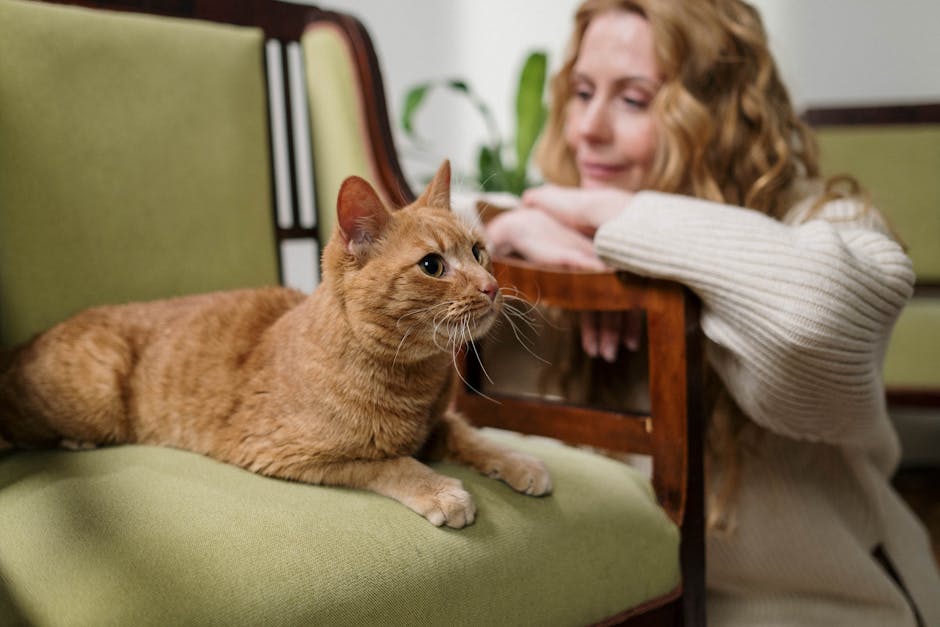“Step into the fascinating world of feline behavior and personalities, where each whiskered companion brings a unique set of traits and quirks to the table. From the playful antics of a social butterfly to the cautious demeanor of a shy observer, understanding the diverse personalities of our beloved cats is key to nurturing a strong and lasting bond. Join us on a journey of discovery as we delve into the seven distinct traits that shape our furry friends, unravel the influence of breed on behavior, and uncover practical solutions for common feline behavior challenges. Get ready to deepen your connection with your cat and enhance your pet-parent relationship with expert tips and insights. Let’s embark on this enriching adventure together, unlocking the secrets to a purr-fect companionship!”

Understanding Feline Personalities: Key Traits Explored
Cats are known for their unique personalities, and understanding these traits can help us build stronger bonds with our feline companions. The seven key personality traits in cats, including fearfulness, activity/playfulness, aggression toward humans, sociability toward humans, sociability toward cats, excessive grooming, and litterbox issues, provide insight into their behaviors. By recognizing and appreciating these traits, cat owners can tailor their interactions and environment to meet their cat’s specific needs, ultimately fostering a harmonious and fulfilling relationship.
Fearfulness is a common trait in cats, with some being more prone to anxiety than others. Understanding and addressing their fears can help them feel more secure and confident in their surroundings. Activity/playfulness is another important aspect of feline behavior, as engaging in play can provide mental stimulation and physical exercise for our furry friends. By incorporating interactive toys and play sessions into their daily routine, we can help cats channel their energy in a positive way and prevent boredom or destructive behaviors.
The Influence of Breed on Cat Behavior: An In-Depth Analysis
The behavior of a cat can be significantly influenced by its breed, with different breeds often exhibiting distinct personality traits. For example, Siamese cats are known for their vocal and social nature, while Maine Coons are typically gentle giants with a friendly demeanor. By understanding the typical characteristics of various cat breeds, owners can better anticipate their pet’s behavior and provide appropriate care and enrichment. Factors such as genetic predispositions, historical roles, and selective breeding practices all play a role in shaping the behavior of specific cat breeds.
Certain breeds may be more inclined towards certain behaviors, such as the high energy levels often seen in breeds like the Bengal or Abyssinian. Providing outlets for their natural instincts, such as interactive toys or climbing structures, can help prevent behavioral issues stemming from boredom or pent-up energy. Additionally, recognizing breed-specific traits can aid in selecting a cat that aligns with your lifestyle and preferences. Whether you prefer a lap cat or an active playmate, understanding how breed influences behavior can lead to a more fulfilling relationship with your feline companion.
Managing Common Feline Behavior Challenges: Practical Solutions
Feline behavior challenges are a common concern for cat owners, but with the right approach, these issues can be effectively managed. Addressing problems like aggression towards humans or other cats, excessive grooming, or litterbox issues requires patience and understanding. For aggression, identifying triggers and implementing positive reinforcement techniques can help modify behavior. Excessive grooming may signal stress or underlying health issues, necessitating a visit to the vet. Litterbox problems often stem from environmental stressors or medical conditions, so ensuring a clean, accessible litterbox and ruling out any health issues is crucial.
Creating a stimulating environment with appropriate outlets for play and mental stimulation can alleviate many behavior challenges. Interactive toys, scratching posts, and vertical spaces for climbing can help prevent boredom and destructive behaviors. Consistency in routine and positive reinforcement techniques can also reinforce desired behaviors and discourage unwanted ones. Seeking guidance from a veterinarian or animal behaviorist can provide tailored solutions for specific behavior challenges, ensuring a harmonious relationship between you and your feline companion.
Enhancing Your Relationship with Your Cat: Tips for Better Understanding
Building a strong bond with your cat is a rewarding journey that requires patience, empathy, and understanding. Observing your cat’s body language and vocalizations can offer valuable insights into their emotions and needs. From the flick of a tail to the pitch of a meow, these subtle cues can help you decipher what your feline friend is trying to communicate. By tuning into these signals and responding appropriately, you can strengthen the connection between you and your cat, fostering trust and mutual respect.
Spending quality time engaging in activities that your cat enjoys, such as interactive play sessions or grooming, can deepen your bond and create positive associations. Respect your cat’s boundaries and preferences, allowing them to approach and interact with you on their terms. Providing a safe and enriching environment with cozy resting spots, scratching posts, and access to windows for bird watching can also enhance your cat’s well-being and overall happiness. By prioritizing your cat’s physical and emotional needs, you can cultivate a harmonious and fulfilling relationship that lasts a lifetime.
“As we wrap up this exploration into the intricate world of feline behavior and personalities, we hope you’ve gained valuable insights that will empower you to strengthen your relationship with your furry companion. By recognizing and appreciating the unique traits and behaviors of cats, you can tailor your approach to meet their individual needs and create a harmonious living environment for both of you. Remember, patience, empathy, and a willingness to learn are the cornerstones of a fulfilling bond with your cat. Embrace the diversity of feline personalities, celebrate the quirks that make them special, and continue to nurture the deep connection you share. Here’s to many more joyful moments and enriching experiences with your purr-fect feline friend. Meow and forever!”












Leave a Reply
View Comments